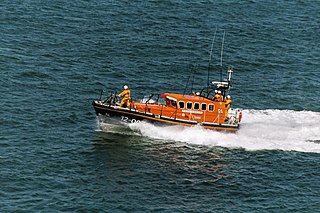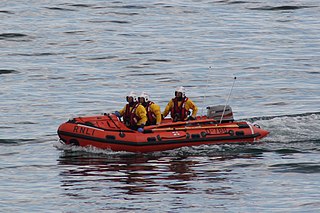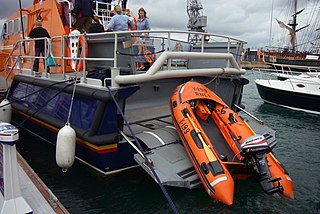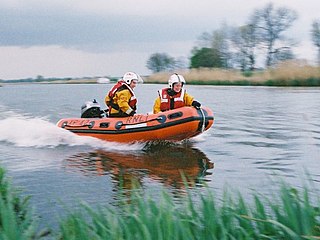
At 17.3 metres long, the Severn class is the largest lifeboat operated by the Royal National Lifeboat Institution (RNLI). Introduced to service in 1996, the class is named after the River Severn, the longest river in Great Britain. They are stationed at 35 locations around the coasts of the United Kingdom and Ireland to provide coverage up to 50 miles (80 km) out to sea.

Mersey-class lifeboats are all-weather lifeboats operated by the Royal National Lifeboat Institution (RNLI) from stations around the coasts of Great Britain and Ireland. They are capable of operating at up to 17 knots (31 km/h) and can be launched from a carriage.

The Tyne-class lifeboat was a class of lifeboat that served as a part of the Royal National Lifeboat Institution fleet until 2019. They were named after the River Tyne in North East England.

Tamar-class lifeboats are all-weather lifeboats (ALBs) operated by the Royal National Lifeboat Institution (RNLI) around the coasts of Great Britain and Ireland. They have replaced the majority of the older Tyne ALBs. The prototype was built in 2000 and 27 production boats were constructed between 2006 and 2013.

The Shannon-class lifeboat is the latest class of lifeboat currently being deployed to the RNLI fleet to serve the shores of the British Isles. The Shannon class is due to replace the Mersey class carriage-launched lifeboat, the remaining Tyne-class lifeboats, and to also replace the Trent-class lifeboats in due course.

The D-class (IB1) lifeboats are inflatable boats serving in the UK's RNLI inshore lifeboat (ILB) fleet. Although they are known as the "IB1" at times, they are the latest development of the D-class lifeboat and as such are mainly referred to as a "D-class".
Since its inception, the Royal National Lifeboat Institution (RNLI) has provided lifeboats to lifeboat stations in the United Kingdom and Ireland.

The Y-class lifeboat is a class of small inflatable rescue boat operated by the Royal National Lifeboat Institution of the United Kingdom and Ireland.

The Arancia-class inshore rescue craft is a class of small inflatable rescue boat (IRB) operated by Surf Life Saving Great Britain, Surf Lifesaving Wales and the RNLI of the United Kingdom and Ireland.

The XP-class lifeboat is a class of small inflatable rescue boat operated by the RNLI of the United Kingdom and Ireland.

RNLB Lester is the ALB lifeboat stationed at Cromer in the English county of Norfolk. Cromer is the first lifeboat station on the east of England coast to receive the latest Tamar-class all-weather lifeboat. The lifeboat became officially operational at 3:55 pm on 6 January 2008. The lifeboat was officially christened Lester on Monday 8 September by the Duke of Kent. The lifeboats name Lester has been created by using parts of the surnames of Derek Clifton Lethern and William Foster, both of whom have been long-term supporters and members of the RNLI. Mr Lethern left £1.23m to the RNLI when he died in 1992 and asked for a new lifeboat to be bought in memory of him and his friend Mr Foster.
A rescue lifeboat is a boat rescue craft which is used to attend a vessel in distress, or its survivors, to rescue crew and passengers. It can be hand pulled, sail powered or powered by an engine. Lifeboats may be rigid, inflatable or rigid-inflatable combination-hulled vessels.

Appledore Lifeboat Station is the base for Royal National Lifeboat Institution (RNLI) search and rescue operations at Appledore, Devon in the United Kingdom. The first lifeboat was stationed in the town in 1825 and the present station was opened in 2001. It operates a Tamar-class all weather boat (AWB) and an Atlantic 75 B Class inshore lifeboat (ILB).

Mudeford Lifeboat Station is the base for Royal National Lifeboat Institution (RNLI) search and rescue operations at Mudeford, Christchurch, Dorset in England. The first lifeboat was stationed on Mudeford Quay 1963 and the present station was opened in 2003. It operates an Atlantic 85 inshore lifeboat (ILB).

Porthdinllaen Lifeboat Station is a Royal National Lifeboat Institution (RNLI) operated lifeboat station in the coastal village of Porthdinllaen, within the community of Dwyfor on the Llŷn Peninsula, Gwynedd, North Wales

Walton and Frinton Lifeboat Station is an RNLI station located in the town of Walton-on-the-Naze in the English county of Essex. The current all-weather boat (AWB) at Walton is the Tamar Class Irene Muriel Rees which is kept moored afloat in a specially constructed pen at the end of Walton Pier. Prior to the construction of this, the boats were anchored in open water to the south of the pier.

Skegness Lifeboat Station is an RNLI operated lifeboat station located in the town of Skegness in the English county of Lincolnshire. The station is located on the south-east coast north of the Wash and south of the Humber Estuary. This area of the British coastline is characterised by many shoals and constantly changing sandbanks, many of which lie between the town and the East Dudgeon Lightship. The current station was built in 1990 and was the first in the British Isles built especially to house a Mersey-class lifeboat. The boathouse also accommodates an Inshore Lifeboat and a souvenir shop.

Calshot Lifeboat Station is located on Calshot Spit near the village of Calshot, Hampshire, and is on the southern bank of the open end of Southampton Water, on the south coast of England. The station is owned and operated by the Royal National Lifeboat Institution (RNLI) and currently operates two inshore lifeboats. They are an Atlantic 85 called Max Walls (B-860) and a D-class (IB1) called RNLB Willett (D-748).

New Quay Lifeboat Station is an RNLI lifeboat station in the coastal resort of New Quay, Ceredigion, West Wales. It was established in 1864 and in 2014 celebrated 150 years of service. In 2014 the station operated two lifeboats: a Mersey class all-weather boat and a D class inshore boat.
















